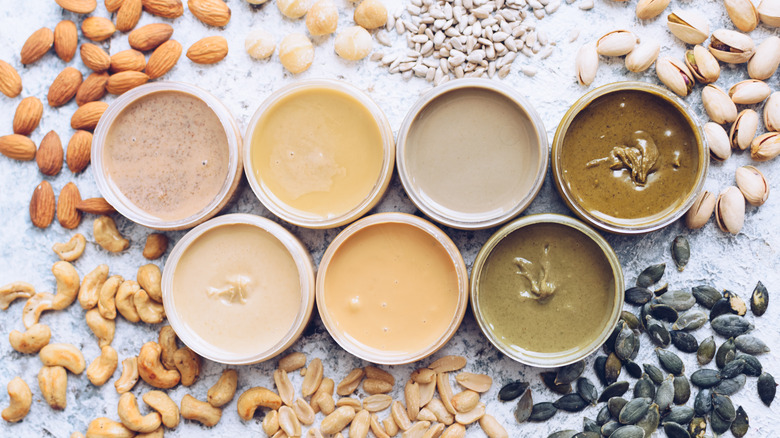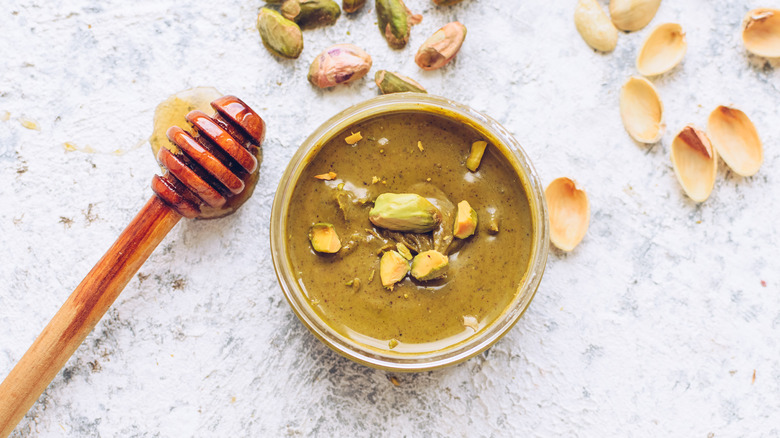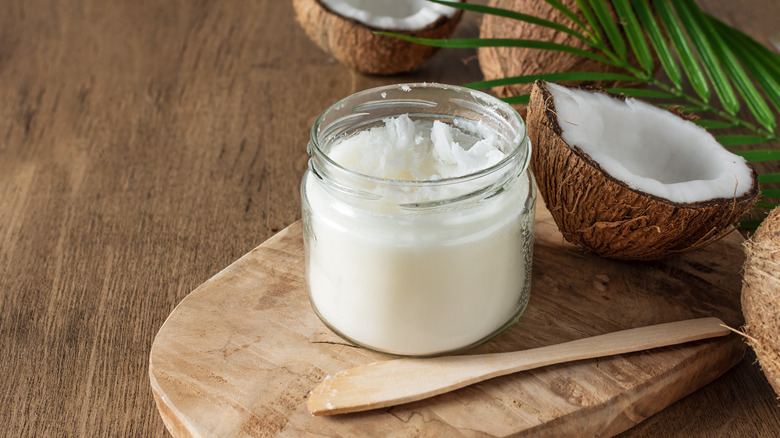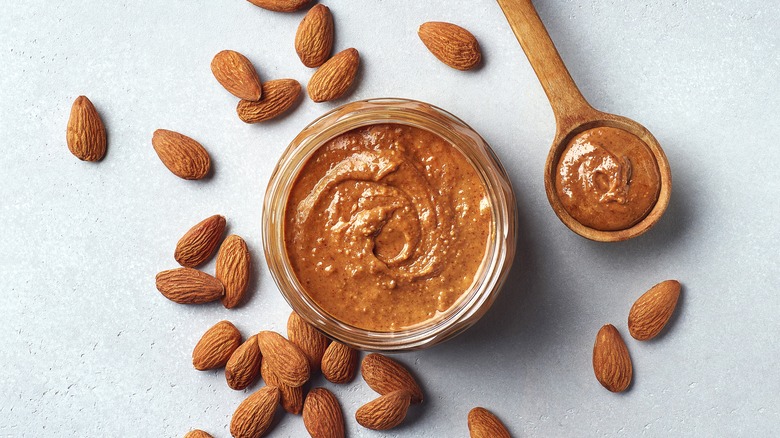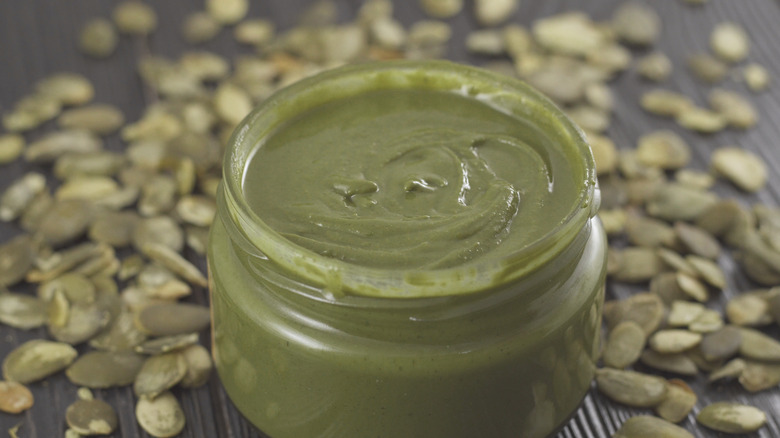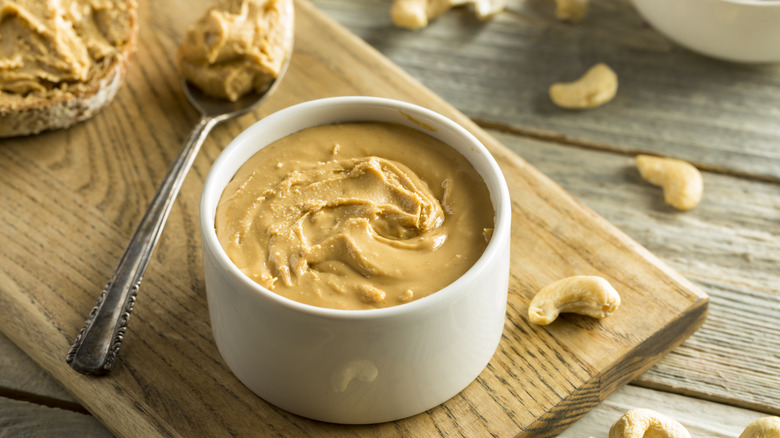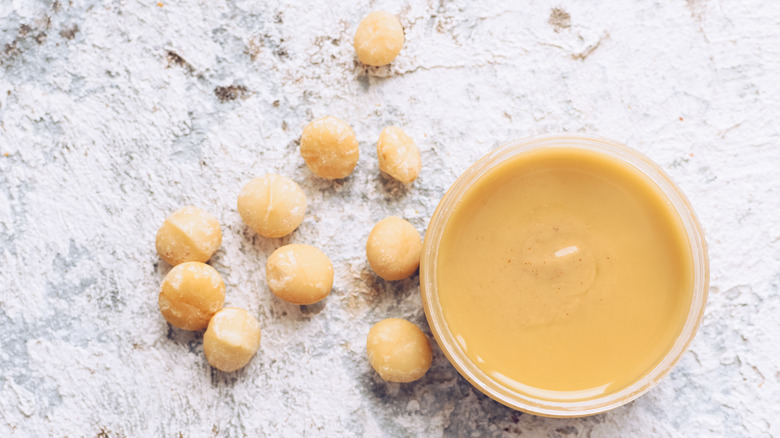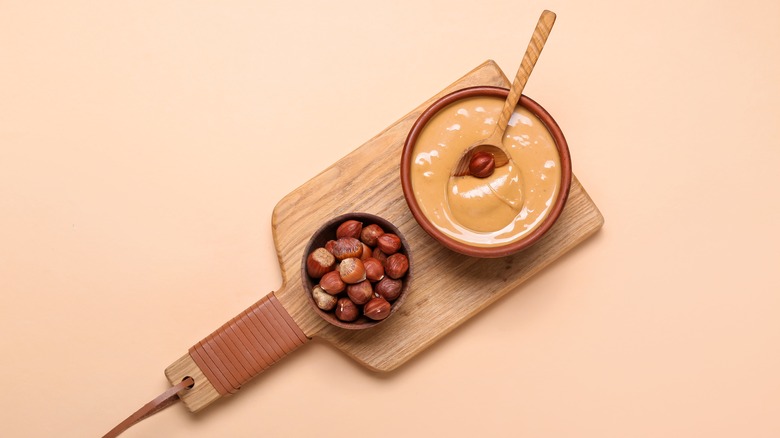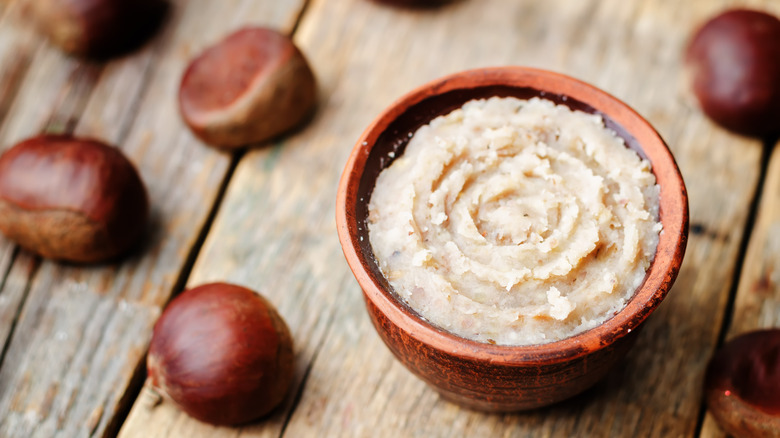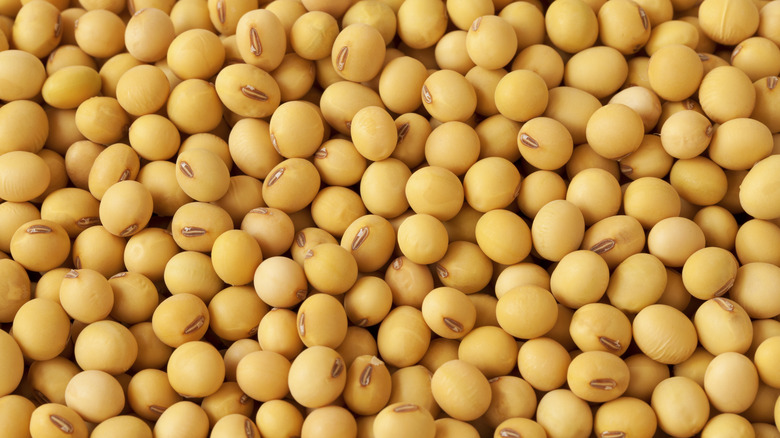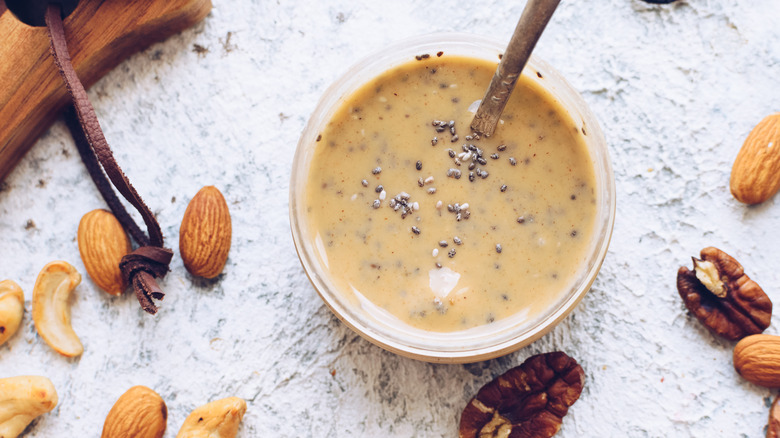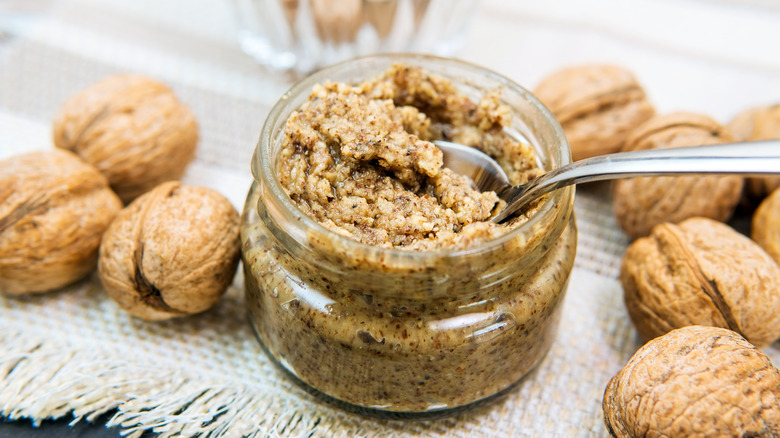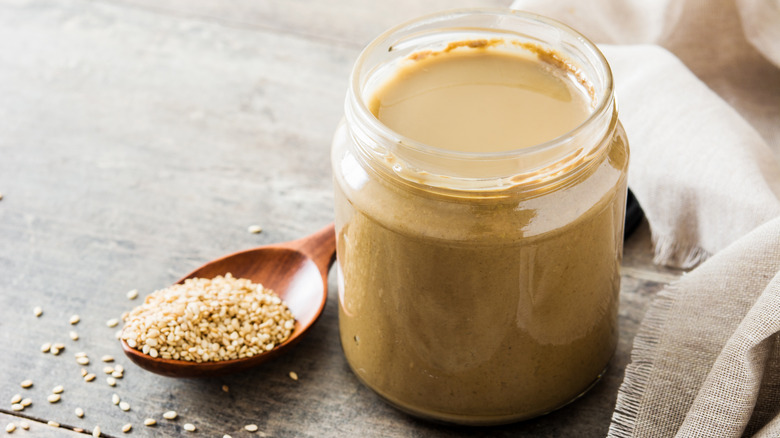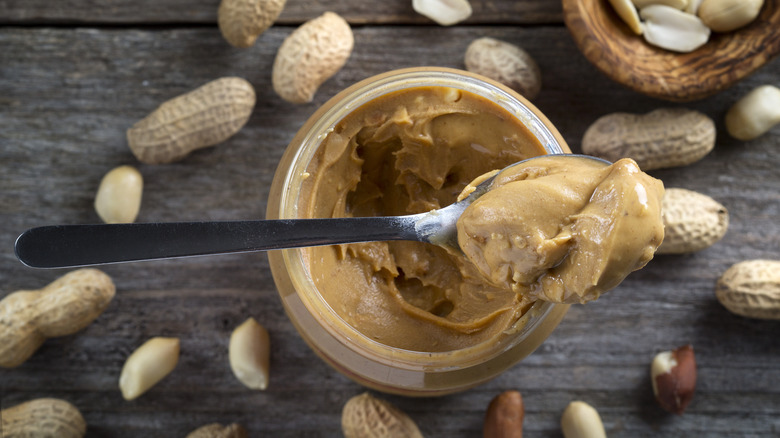13 Types Of Nut And Seed Butters And How To Use Them
We all know of peanut butter, the infamous ingredient in PB&Js or Thai satay sauce, but are you familiar with the numerous other nutty spreads out there? Beyond peanut butter, there is a world of nut and seed butters that are just as delicious and useful in recipes. From sweet hazelnut butter or coconut butter to rich macadamia nut butter, you can find a creamy, nutty spread perfect for just about anything. Between sauces, desserts, dressings, and snacking, the right nut butter can be the ingredient that takes a dish to the next level. Whether you're spicing up your morning toast, amplifying a pasta dish, or giving your smoothie a nutritious boost, nut and seed butters can help do the trick.
But it's not just about versatility and taste — these butters are also nutritional powerhouses, brimming with essential vitamins. Between healthy fats, protein, and more, they offer several health benefits. Plus, they're rather simple to make, store, and use. Here, we'll explore the different varieties of nut and seed butters and the many ways you can incorporate them into your favorite recipes.
Pistachio butter
As you might expect, pistachio butter has a slightly nutty flavor, but it's also somewhat sweet. Pistachios are rich in vitamin B6, protein, and antioxidants. Plus, they contain good amounts of copper, manganese, and potassium. As a result, pistachio butter is also full of nutritional value, especially when you buy organic or make it yourself. At home, pistachio butter is easily made with a food processor and unsalted pistachios (ideally lightly toasted), but you can always add a dash of salt to enhance the earthy natural flavors. Before you open a jar of pistachio butter, it's best stored in a cool, dry place, but you can also keep it in the fridge. Depending on the brand, a six-ounce jar costs about $13-14 on average.
As far as how to use pistachio butter, there are a few obvious ways like making a Thai sauce or salad dressing, much like you would with peanut butter. Alternatively, you could swirl it into yogurt, blend it into smoothies, or make a pistachio pesto for pasta. You can also use it as a topping, filling, or frosting for desserts; for a particularly indulgent option, it can work very well in baklava.
Coconut butter
Coconut butter tastes, well ... coconutty. Unlike coconut oil, which is also used in cooking, coconut butter is creamy, slightly sweet, and thicker than oil. It also has dietary fiber, which coconut oil doesn't, plus potassium, magnesium, iron, and protein. To make coconut butter at home, you have to grind coconut flesh (or dried coconut flakes) into a buttery paste. Even though coconut butter is still packed with coconut oil, it's perfectly safe for up to two weeks when it's stored at room temperature. While you can put it in the fridge, it'll end up hardening — coconut oil solidifies below 78 degrees Fahrenheit, so your fridge will freeze it solid. You'll want to bring it back to room temperature before using it, to keep it creamy and easy to spread. On average, you can buy some for about $12 per pound.
Because coconut butter has such a distinctive flavor, it's a delicious topping for pancakes or waffles, but you can also add it to other breakfast foods like oatmeal, smoothies, or yogurt. Coconut butter even works when mixed into savory dishes, such as sauteed vegetables, mashed potatoes, or curry sauce. If you're not sure how you'll feel about the taste, try spreading it on your toast first.
Almond butter
One of the more popular nut butters, almond butter is packed with the characteristic flavor of almonds, and is slightly sweet. Because it's made from ground almonds, it can sometimes be gritty or crunchy in texture, unlike creamier nut butters. Almond butter is rather high in monosaturated fats, which can contribute to heart health and cholesterol levels in a positive way, per WebMD. It's also rich in vitamin E and omega-3 fatty acids, which can also improve heart health. Moreover, almond butter contains calcium, iron, potassium, magnesium, and fiber. A 12-ounce jar of almond butter can cost as little as $5, depending on the brand, and is best stored in a dark, cool area away from any moisture. If you want to double its shelf life, you can refrigerate almond butter.
Almond butter is a great substitute for peanut butter, and works just as well on toast, in sandwiches, and as a dip for fruits or veggies. You can blend it into sauces, dressings, smoothies, or baked goods, or use it for a nutty butter and fruit panini.
Pumpkin seed butter
Earthy, nutty, and creamy, pumpkin seed butter is a wonderful choice if you have a nut allergy or need a nut-free option — per The American Academy of Allergy, Asthma & Immunology, people with nut allergies usually have no problems with these seeds. It's made with raw pumpkin seeds, a little oil (like avocado oil or nut oil if you want some of that extra nuttiness), and a pinch of salt. Homemade pumpkin seed butter can be stored in the fridge in an airtight container, while store-bought butter usually can go right in a dark pantry. Aside from the distinct flavor, this creamy spread is also full of nutritional value; pumpkin seeds are rich in protein, healthy fats, magnesium, manganese, zinc, iron, and phosphorus.
You can use pumpkin seed butter much like any nut butter. It's delicious spread on toast or bananas, and can also be used to add a nutty element to smoothies or desserts without actually using nuts. Because it's earthy and savory, it complements fruits and makes an ideal dip, but it's also great for salad dressings and sauces. The price varies depending on where you buy it, a typical price is around $7 for a 14-ounce container.
Cashew butter
Considered one of the more mild nut butters, cashew butter is creamy, somewhat sweet, and almost like a tamer version of peanut butter. Like other nutty spreads, cashew butter is high in protein and healthy fats. In general, cashews contain iron, vitamin K, calcium, magnesium, and phosphorus.
Besides the health benefits it offers, cashew butter is very versatile in recipes. Just as you can easily spread it on crackers or toast, you can also use it in sauces or soups for creaminess. It makes a great dip for fruits and vegetables and a nutty addition to desserts and baked goods like muffins, loaves, or brownies. If you want to try making it at home, consider this sweet ginger cashew butter recipe. The most inexpensive cashew butter available can cost just over $5. Ideally, you should store it in a cool, dark place, in an airtight container unless the manufacturer says otherwise. If it's homemade, it's best kept in the fridge to prevent it spoiling.
Macadamia nut butter
Macadamia nut butter is rich, somewhat sweet, and naturally nutty. You can make it at home by pureeing raw macadamia nuts in a food processor or strong blender, and mixing the puree with coconut oil and a little bit of salt to bring out the flavor. It doesn't last as long as other nut butters; typically, homemade macadamia nut butter lasts about two weeks on the countertop and around two months in the fridge. This butter is relatively healthy — macadamia nuts are full of healthy fats, fiber, manganese, vitamin B6, and thiamine. The nuts also contain antioxidants, as well as vitamin E, which can help protect your body from certain diseases.
To incorporate it into your recipes at home, try blending it into smoothies or protein shakes, mix it into cookies, or combine it with another kind of nut butter. You can use it in just about any recipe that calls for peanut butter, which includes spicy sauces, satays, and sandwiches. Something you may already know about macadamia nuts is they're one of the more expensive nuts. Because of this, macadamia nut butter is on the pricier end, comparatively, and no matter which brand you buy, a jar of it often costs over $20.
Hazelnut butter
Hazelnut butter, which is different from hazelnut spread or Nutella, is nutty, sweet, and rich. It can be made with a dash of cocoa, bringing it closer to a chocolatey, hazelnut spread, but it's still generally healthier. Unlike sugary hazelnut spreads, the butter is a more concentrated version of the nut. Hazelnuts contain antioxidants, potassium, copper, manganese, magnesium, dietary fiber, and calcium. In fact, they provide nearly 90% of the suggested daily intake for manganese, which is very impressive; manganese supports brain function and bone health, as well as helping to curb inflammation, according to Cleveland Clinic.
With its sweet flavor, hazelnut butter is delicious when spread on pancakes or used as a filling for pastries. You could also simply spread it on toast or use it as a dip for bananas or strawberries. Another way to use hazelnut butter is to add a dollop to your coffee. Not only is butter a way to add creaminess to coffee, but hazelnuts will add a rich complexity to the beverage. You can make or buy this nut butter, and you'll find an 8-ounce jar of organic hazelnut butter on sale for about $15. Just remember that hazelnut spread is not the same, and will typically be cheaper. To store hazelnut butter, it's best to seal it tightly in a jar and keep it in a dark, cool cupboard, though keeping opened jars in the fridge will help it keep its fresh flavor longer.
Chestnut butter
If you're one for chestnuts roasted over an open fire, then chestnut butter is the nut butter for you. Not only is it earthy and sweet, but chestnuts are rather healthful. They contain good amounts of fiber, magnesium, potassium, and antioxidants. Unlike other nuts, chestnuts are particularly rich in vitamin C which, per an article in the journal Nutrition, can help to boost your immune system in numerous different ways. This butter is easy enough to make at home by blending roasted or boiled chestnuts, which is typically how you'll get to enjoy it. While you can buy it, it's not as commercially available as other nut butters — chestnut spread is more commonly found, and is much sweeter than chestnut butter.
You can enjoy chestnut butter with your favorite bread, toast, or crackers for a simple snack. Chestnut butter can also be mixed into cookies, ice cream, or frosting, and it can be used as a pastry filling. For a savory dish, try chestnut butter in stews or on a cheese platter alongside assorted nuts. To keep it at its freshest, store homemade chestnut butter in the fridge for about three weeks in an airtight container.
Soy nut butter
Comparable to peanut butter, soy nut butter is somewhat sweeter and a good alternative if you have a nut allergy. However, soy is also a common allergen, which you may want to consider if trying to make a more allergy-friendly dish. Nonetheless, soy nuts are high in protein, omega-3 fatty acids, fiber, and nutrients like B vitamins. Contrary to what their name suggests, soy nuts are actually not nuts at all. Rather, they are mature soybeans, and the butter is made by pureeing them into a creamy spread along with oil and salt.
Because this butter is nut-free, it's a common replacement for nut butter in various recipes. You could use it for your PBJs, your ants-on-a-log, or your protein shakes. Even in baked goods, soy nut butter has its place, from cookies to granola bars. If you make it at home, it'll keep for about a month in an airtight jar in the fridge. If you buy it, you'll want to check the brand's expiration date. For a 17-ounce jar of Wowbutter's soy nut butter, you'll spend around $13.
Pecan butter
Butter pecan and pecan butter are close enough to be cousins, perhaps, but the two things they have in common — pecans and butter — are what define and separate them. Pecan butter is a naturally sweet, rich nut butter, while butter pecan, among our favorite ice cream flavors, is entirely different. However, pecan butter is still a great way to add a sweet, nuttiness to desserts. You can bake it into cookies, brownies, or fudge just as easily as you can fill a sandwich with it. Pecan butter also makes tasty, creamy sauces, soups, or satays.
In general, pecans are high in healthy fats and contain folate, vitamins A, B6, and E, calcium, and iron, among other essential micronutrients. If you buy pecan butter, you should keep it in a cool, dark cupboard but it can help to refrigerate it after opening. Typically, you can find pecan butter at the store for anywhere between $8 to $17, depending on the jar size and brand. You can make it at home without needing to add any oil, and with only a pinch of salt for flavor. For a more flavorsome twist, you can also infuse it with other flavors like cinnamon, nutmeg, maple, cocoa, praline, or fruits like peach and apple.
Walnut butter
More bitter than other nut butters, walnut butter is also somewhat mild and naturally nutty. If you make it yourself, walnut butter could benefit from sweeter flavors like cinnamon, honey, praline, maple, or coconut. You'll also find it often in mixed nut butter varieties, which can consist of any combination of nuts and seeds. How long walnut butter lasts can vary. Commercially made butter can stay good for up to six months in the fridge. Homemade walnut butter can easily go rancid, so it's advisable to keep it in the fridge, where it can last between one and six months. In the supermarket, you can find a 9-ounce jar of walnut butter for around $7.
Like many other nut and seed butters, walnut butter is easily incorporated into your favorite dishes, be it smoothie bowls, cakes, cookies, or toast topping combinations. It also works in fruit wraps, crepes, or chocolatey treats. Because walnut butter is somewhat bitter, it pairs well with savory sauces and salad dressings, too. Aside from the many ways to use walnut butter, walnuts themselves are also rather healthy. In addition to various essential vitamins, they contain decent amounts of selenium, omega-3 fatty acids, antioxidants, and protein.
Sesame butter (Tahini)
Made with ground sesame seeds, sesame butter is slightly bitter, with a distinctively nutty and earthy flavor. Also called tahini, this nut butter is high in fiber, protein, and copper, and also contains selenium, iron, calcium, and phosphorus. You can make it at home, or you can buy it at the store for as little as $8, although $15 is a more typical price. To make tahini at home, you can blend untoasted sesame oil with ground sesame seeds and a little salt, and serve it with a lot of different dishes. It's relatively simple to make but only keeps in the fridge for about a week. On the other hand, store-bought tahini is likely to have a longer shelf life.
Traditionally, tahini is popular in Mediterranean cuisine and in dishes like hummus, falafel, and baba ganoush. We recommend this pumpkin mutabbal or a miso-tahini dressing. Additionally, you could dip veggies in sesame butter, spread it on toast or sandwiches, or mix it into bread dough.
Peanut butter
If you think we forgot about the most famous of nut butters, we assure you that we did not. While at the bottom of our list, peanut butter is a nut butter worthy of praise. Organic peanut butter, in particular, contains a good amount of healthy fats and protein without the added sugars found in non-organic varieties. According to WebMD, peanut butter is a good source of omega-3 fatty acids and antioxidants. All-natural peanut butter can be stored in the fridge to prevent spoilage, but store-bought brands may have deviations in their storage instructions. Commercial peanut butter lasts for two to three months once opened, and homemade can have a similar lifespan if kept in an airtight refrigerated container.
No matter whether you buy processed or organic, you're not usually going to spend more than a few dollars at the store. Plus, you could always try making it yourself at home with raw peanuts. The simplest method uses nothing but peanuts, but you can also add a little oil, salt, and any flavors you want. If you're short on ideas on how to use peanut butter or are tired of the classics, we suggest some lamb satay, Thai peanut chicken wings, or a peanut butter veggie pasta salad.
